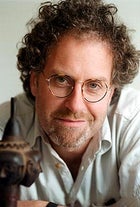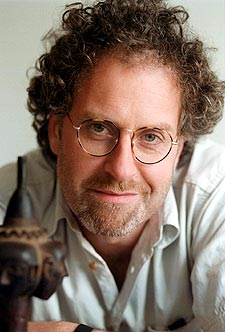Irish photographer Seamus Murphy’s work accompanies Patrick Symmes’s story of the Nepalese guerrillas who revere Mao and seek to take over the country. To bring his incredible photographs even more to life, Murphy answered some of our questions about the trip and about his work.
 Seamus Murphy
Seamus Murphy║┌┴¤│ď╣¤═° Online: Do you always shoot in black and white as you did in these pictures? What informs your decision to shoot in black and white?
Seamus Murphy: Not always, but if given the choice I would practically always opt for black and white. I love color and enjoy using it when I am on assignment with enough time to do it justice. I love graphic compositions, and black and white is bolder than shooting in color, less options to distract the photographer and the person seeing the picture├éÔÇöso this gives the photographer more control of the image. And you need all the control you can get when you consider the fleeting nature of what we are trying to capture. Writers on the same assignment can observe something from a distance, overhear a conversation about the event they are writing about, fantasize a scenario and have fun with the notion, and that’s all part of what they end up delivering as their story. If we are one foot too far or too close to something we want to photograph, in the way we want to describe it├éÔÇötough luck.
Q: When you went to Rolpa to meet the Maoists, you left Kathmandu in a hurry and traveled light├éÔÇöwhat kind of camera equipment did you bring with you? How did you transport it?
A: I brought one backpack, as I knew we would be trekking uphill and in very heavy, humid conditions. I packed two camera bodies, three lenses and lots of film. And some spare socks. The lenses were a 17-35mm wide-angle zoom, an 85mm lens and, as a back-up in case the zoom broke down, or I dropped it, a 28mm lens. As luck would have it, the Maoists were incredibly hospitable and graciously supplied blankets, which we needed as the nights were cold. Without the need for camera gear, Patrick, the writer, packed a sleeping bag, an inflatable pillow, and all sorts of high nutrition food bars and glow sticks to keep the guerillas amused. And then I had to lend him a pen.
Q: How much do you speak to people before you photograph them? Do you direct the composition of the picture?
A: Depends on the situation. Usually its best to be distant and unobserved, you are trying to capture something real├éÔÇöan expression, a movement, a composition├éÔÇöand if you engage the people beforehand, you ruin the spontaneity. There are times, in a portrait say, where you want someone in a certain light├éÔÇöas in the picture of the elderly refugee. I had taken some pictures of him in the shade outdoors but the lines on his face really were spectacular and I knew I needed very soft sidelight to emphasize the relief of his skin├éÔÇöso I found the place and asked him to come with me. The light was extremely low├éÔÇöI shot it├é┬áhandheld on f2.8 at 1/10 second at 3200ASA.
Q: Your pictures of the rally are simply spellbinding├éÔÇöone looks at them and feels like he’s there. How do you approach an event like this such that you’re able to achieve that immediacy?
A: You do your best and hope you’ve done it justice. I was conscious of trying to capture the expansive nature of the huge crowd, but also not to lose the immediacy├éÔÇöthese are human beings and although they may be engaged in a mass rally, each one is an individual├éÔÇöso its important to get the humanity├éÔÇölike the picture of the woman enjoying herself smoking what grows wild on the foothills. But obviously the impact of the scale of people is vital.
Q; In the article, Symmes writes that you were told not to take pictures without permission, but that you did so. How do you go about breaking this rule? What clues tell you what the real consequences are?
A: I reckoned we were guests of the Maoist leadership, and they knew we were Western press, and they also knew what we were there for. They were very proud of the turn-out at the rally. I’m not saying all the crowd (or even most of them) were willing participants in the revolution being declared, but the numbers were impressive. So we were useful to them├éÔÇöafter all if they were going to be that strict they could have made a condition like, give us your cameras until we say you can shoot. So they were behaving like most people in power, pretending not to want us but in reality needing us.
Q: What was the worst moment of the Nepal assignment?
A: Getting to the rally. We hired a driver with a rickety four-wheel drive van, who seemed to blame Patrick and I for the condition of the roads to Rolpa. They were horrendous, but that was hardly news and in a series of increasingly ridiculous japes, the driver and his assistant tried to show us that the vehicle couldn’t make the journey. At first it was intriguing, then it grew very irritating as we were losing time and thought we could possibly miss the whole event. If we hadn’t been persistent in reminding them we were paying them very good money for taking us all the way to the borders of the Maoist areas, we would have missed it.
Q: What was the best?
A: We didn’t believe them. We couldn’t believe them. They kept saying “There will be 10-15,000 followers, militia and Red Army soldiers at the rally.” Yeah sure. We were in an incredibly remote part of Nepal, very high up in the atmosphere, in terrain that was back-breaking to climb and treacherous underfoot. Then suddenly, around a corner it was Fellini. Muskets firing, music playing and the masses on the march, 10,000 filing in neat lines onto an escarpment to form the rally. Unbelievable.
Seamus Murphy has worked all over the world, including assignments in Afghanistan, Sierra Leone, Ethiopia, Southern Russia, and Rwanda. To see some of these photographs, click on the following links:

